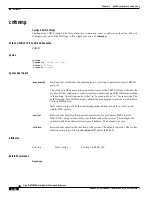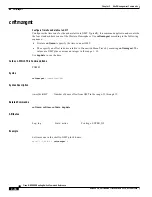
2-22
Cisco MGX 8850 Routing Switch Command Reference
Release 2.0, Part Number 78-10467-04 Rev C0, October 2001
Chapter 2
Shelf Management Commands
cnfclksrc
•
AXSM-sourced clocks require that the lines, ports, and resource partitioning have been configured.
•
A switch can have one primary source and one secondary source.
•
For each execution of cnfclksrc, you can specify only one clock source (either but not both primary
and secondary). Therefore, you must repeat cnfclksrc to specify the other clock source.
•
If you do not to specify a secondary source, the internal oscillator serves as the secondary source.
•
For clock sources on the AXSMs, Cisco recommends that primary and secondary sources be on
separate cards or at least on separate lines.
•
Revertive mode applies to only a primary BITS clock. For more details on the revertive option, see
the section, “
Configuring a BITS Clock
.”
•
The switch constantly monitors the state of the clocks. For information on clock alarms, see the
dspclkalms description.
Changing the Priority of a Clock Source
To change the priority of a clock source, the command sequence depends on the priority of the sources:
•
To change the priority of a clock from primary to secondary or secondary to primary, you must first
execute delclksrc to deconfigure each source.
•
To change from one primary source to another primary source, you need to execute only cnfclksrc
for the new primary source—the system automatically deconfigures the existing primary source.
Configuring a BITS Clock
You can configure a node to obtain its primary and secondary clocks through the BITS circuitry on the
PXM-UI S3. (The PXM-UI S3 has two connectors to receive highly stable clocks from an external
device. The PXM-UI S3 can support stratum levels 1–3.) If the primary and secondary clocks are
externally-sourced, they must be the same rate. For example, you cannot specify a T1 primary source
and an E1 secondary source.
Note
Whenever the internal oscillator becomes the primary or secondary source due to a failure, a minor
alarm is triggered on the local node.
You can enable a revertive mode for the primary BITS clock. The revertive function on the PXM45
applies when the primary clock source fails. A failure is a loss of the primary clock source after the node
has locked to that clock source. If a primary clock recovers from a failure and revertive mode is enabled,
the node automatically reverts to the primary source. The restored primary clock must be available for
12 seconds before it again becomes the active clock source.
If the primary clock source fails and revertive mode is disabled, you must re-configure the primary
source after the failure has been corrected.
To change the mode from revertive to non-revertive, execute cnfclksrc. Follow the portID and priority
with “–revertive disable.”
Note
For an E1 BITS clock, the current product is automatically limited to two parameters of an E1 line
that is used as a BITS source: twisted pair cabling and date-type signaling.
Related Commands
dspclksrcs, delclksrc, dspclkalms
















































